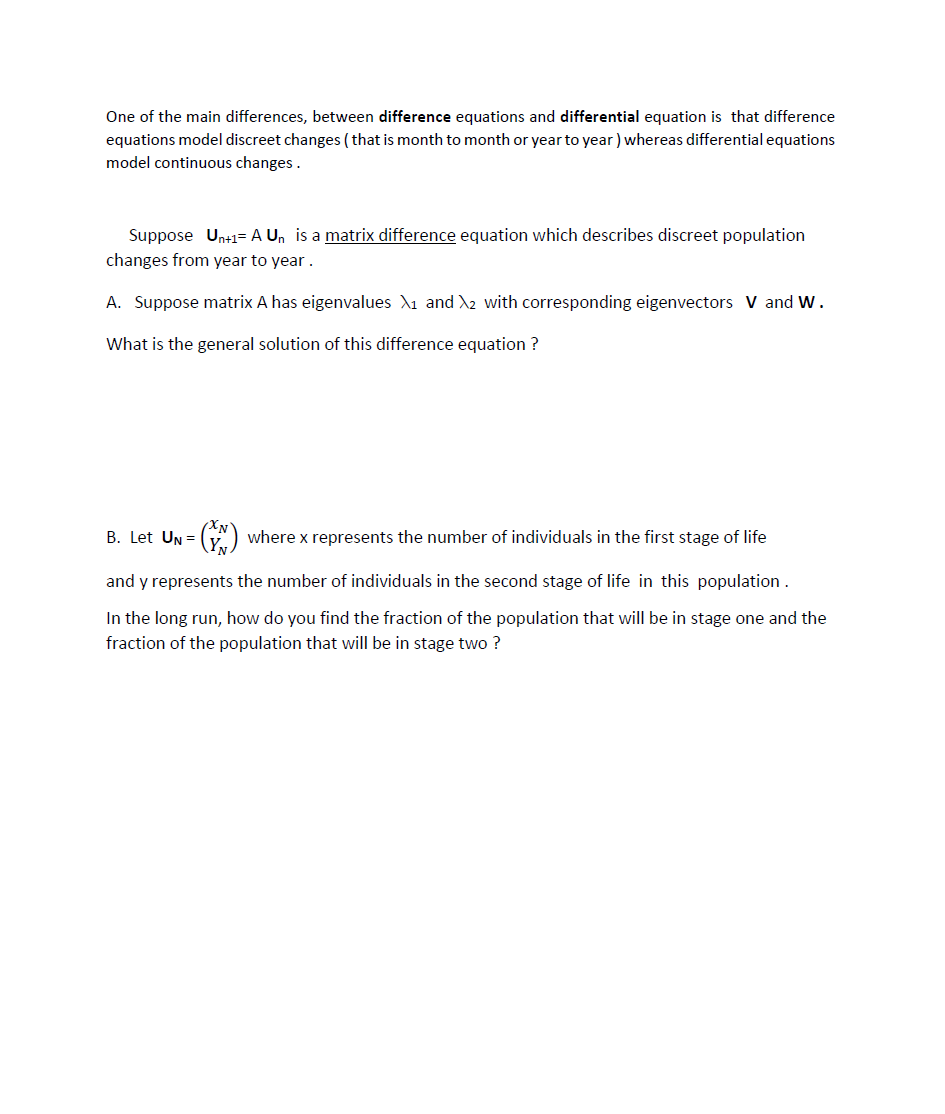Suppose Un+1= A U₁ is a matrix difference equation which describes discreet population changes from year to year. A. Suppose matrix A has eigenvalues X₁ and X2 with corresponding eigenvectors V and W. What is the general solution of this difference equation? B. Let UN = (Y) where x represents the number of individuals in the first stage of life and y represents the number of individuals in the second stage of life in this population. In the long run, how do you find the fraction of the population that will be in stage one and the fraction of the population that will be in stage two ?
Suppose Un+1= A U₁ is a matrix difference equation which describes discreet population changes from year to year. A. Suppose matrix A has eigenvalues X₁ and X2 with corresponding eigenvectors V and W. What is the general solution of this difference equation? B. Let UN = (Y) where x represents the number of individuals in the first stage of life and y represents the number of individuals in the second stage of life in this population. In the long run, how do you find the fraction of the population that will be in stage one and the fraction of the population that will be in stage two ?
Linear Algebra: A Modern Introduction
4th Edition
ISBN:9781285463247
Author:David Poole
Publisher:David Poole
Chapter4: Eigenvalues And Eigenvectors
Section4.6: Applications And The Perron-frobenius Theorem
Problem 70EQ
Related questions
Question

Transcribed Image Text:One of the main differences, between difference equations and differential equation is that difference
equations model discreet changes ( that is month to month or year to year) whereas differential equations
model continuous changes.
Suppose Un+1= A Un is a matrix difference equation which describes discreet population
changes from year to year.
A. Suppose matrix A has eigenvalues X1 and Xz with corresponding eigenvectors V and W.
What is the general solution of this difference equation ?
B. Let UN =
where x represents the number of individuals in the first stage of life
and y represents the number of individuals in the second stage of life in this population .
In the long run, how do you find the fraction of the population that will be in stage one and the
fraction of the population that will be in stage two ?
Expert Solution
This question has been solved!
Explore an expertly crafted, step-by-step solution for a thorough understanding of key concepts.
Step by step
Solved in 3 steps

Recommended textbooks for you

Linear Algebra: A Modern Introduction
Algebra
ISBN:
9781285463247
Author:
David Poole
Publisher:
Cengage Learning

Algebra & Trigonometry with Analytic Geometry
Algebra
ISBN:
9781133382119
Author:
Swokowski
Publisher:
Cengage

Elementary Linear Algebra (MindTap Course List)
Algebra
ISBN:
9781305658004
Author:
Ron Larson
Publisher:
Cengage Learning

Linear Algebra: A Modern Introduction
Algebra
ISBN:
9781285463247
Author:
David Poole
Publisher:
Cengage Learning

Algebra & Trigonometry with Analytic Geometry
Algebra
ISBN:
9781133382119
Author:
Swokowski
Publisher:
Cengage

Elementary Linear Algebra (MindTap Course List)
Algebra
ISBN:
9781305658004
Author:
Ron Larson
Publisher:
Cengage Learning

College Algebra (MindTap Course List)
Algebra
ISBN:
9781305652231
Author:
R. David Gustafson, Jeff Hughes
Publisher:
Cengage Learning